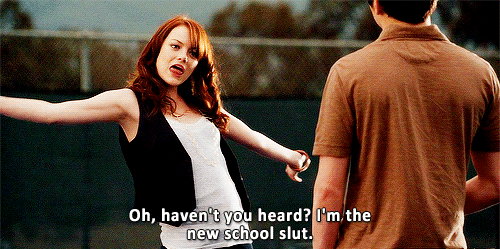Movie
to watch for this week is also related to Feminist Film Theory. It’s Easy A!
Feminist Film Theory
Started in 1920s, the theory looks
at women’s expression of her own subjectivity. The theory gets matured in the
late 1960s, after the radicalized feminist movement (regarding sexual
liberation and political debate of female representation).
Talk about feminism, it is a set of
political practices which can be seen through the analyses of the social or
historical position of women as subordinated, oppressed or exploited in
dominant modes of production (such as capitalism) and/or by social relations of
patriarchy or male domination.
Films
is viewed as a reflection of the society, hence, we tend out seek the
ideological and social construction of women in films. The themes explored in
this theory include discrimination, stereotyping, objectification, oppression
and patriarchy.
Film theorist Christian Metz argues
that viewing film is only possible through scopophilia. Laura Mulvey who is
also a film theorist, joined the discussion of visual pleasure of females on
screen, which is known as ‘the gaze’. She expanded on the concept of
scopophilia to introduce visual pleasure and identification with the on screen
male actors. She mentioned female actresses on screen can be seen as
exhibitionist (enjoy the pleasure of being looked at). They are the symbol of
eroticism and visual pleasure. Thus, holds the tendency of
“to-be-looked-at-ness” and “bearer of meaning”.
Mulvey said cinema is a medium of
voyeurism where visual pleasure is derived with the perspectives of looking.
And so, there are 3 perspectives:
i) Male character
looking at the female character in the film.
ii) Audience in
cinema looking at the female character in the film.
iii) Audience in
cinema looking through the eyes of the male character who is looking
at the female character.
There are several ways to look at
feminism in films.
i) Assumed
predetermined sexual identity to expose the misrepresentation of women in films.
This refers to the female repression by a patriarchal society.
ii) Look at the
various female representations in the film and compare them, the ‘preferred’
female representation will present in the end of the film.
iii) Look at the
female representations of the film from the female spectator’s point of view.
There are more ways to interpret feminism in films. As what mentioned above, films is viewed as the reflection
of the society, elements like race, social class can also be included for the
discussion.
Example films that applied the
theory are such as The Hours (2002), Erin Brockovich (2000) and I Shot Andy Warhol (1996).
Synopsis
A high school girl Olive Penderghast lies to
her best friend Rhi about going on a date with a guy so that she can avoid
going to Rhi’s house and meet her strange parents. The lie gets bigger and
becomes a rumour. It’s about how Olives goes from being a ‘nobody’ to
‘somebody’, and how she survives through the rumour.
Analysis
The five female representations
appeared in Easy A are as below:
i)
Olive Penderghast
An independent,
kind and smart lady. Since everyone think she is a slut, she challenges them
and be the “slut”. Although Olive is in trouble, but she is still kind enough
to assist others to solve their problems.
The
objectifiction exists in Olive’s character. Some guys approaches her as an
object of desire, and some approaches her to get some sort of clarifcation. In
addition, her image after the rumour spread is oppressed by the system
defintion of “slut”. The way she dresses and walks, the whole school gossips
and attack her without really knowing the truth.
ii)Rhi
Olive’s best
friend. A typical dumb blonde and open-minded lady who loves to discuss about
sex. She is blinded by the lies that Olive told her even though Olive wants to
clarify the truth.
iii)
Marianne
A typical good
student as she’s an active members in several school clubs. Also, a very
religious person. At first, she treats Olive badly due to the rumour, but then
she starts to treat her nicely as she thinks Olive understands her.
iv)
Mrs Griffith
The counselling
teacher of the high school. She tends to ignore the truth and believe the
rumour about Olive. Mrs Griffith also uses Olive to hide the fact that she
slept with a student in which the student lies that he slept with Olive to
cover another truth.
v)
Mrs Penderghast
Mother of Olive,
very easygoing person. She cares about her daughter a lot.
Apart from what stated above, low
camera angle, slow motion, blurring of background and focus on Olive is applied
to sharp her as the "attention" of the school.
Conclusion
Emma Stone really shines in this
film, a very different charisma from what I seen from her in Zombieland! Other than the “female
power” message delivered, this film also educate people not to bully the weaker
one. And for the vicitm, this film is a reminder that you might seem alone, but
you’re stronger than you think. Just like Olive, she is able to turn the table!
Last but not least, don’t underestimate the power of rumours. The reality is
people won’t notice what good deed you did but once they notice something bad
from you, it spreads way more than you think.
Ladies,
be strong! Don’t get defeated!
Reference
1- Film Studies lecture notes


No comments:
Post a Comment